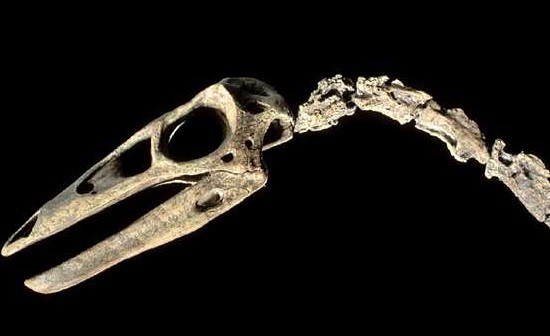 At the end of the 19th century, the American West was the scene of many fortuitous discoveries of large deposits of fossils of dinosaurs! The public is passionate, the Museums compete to obtain always more specimens and in this unique context two men, two paleontologists, two old friends, will engage in a merciless struggle to find and describe the greatest number of dinosaurs possible. With dynamite, under the shovels, pickaxes, hammers and chisels reappear Coelophysis, Allosaurus, Diplodocus, Stegosaurus, Triceratops … Cope and Marsh will not hesitate to spy on each other, to sabotage the discoveries of the other, to bribe the workers, to divert the supplies… The brush in one hand, the rifle in the other, they will push their research until in Indian Territory, waging what history remembers as the "Bone War .
At the end of the 19th century, the American West was the scene of many fortuitous discoveries of large deposits of fossils of dinosaurs! The public is passionate, the Museums compete to obtain always more specimens and in this unique context two men, two paleontologists, two old friends, will engage in a merciless struggle to find and describe the greatest number of dinosaurs possible. With dynamite, under the shovels, pickaxes, hammers and chisels reappear Coelophysis, Allosaurus, Diplodocus, Stegosaurus, Triceratops … Cope and Marsh will not hesitate to spy on each other, to sabotage the discoveries of the other, to bribe the workers, to divert the supplies… The brush in one hand, the rifle in the other, they will push their research until in Indian Territory, waging what history remembers as the "Bone War .
The end of a friendship
Edward Drinker Cope came from a wealthy Protestant family (Quakers) in Philadelphia, he studied natural sciences, became a member of the Academy of Natural Sciences in 1864 and then professor of zoology at Haverford College. He spent three years in Europe at the insistence of his father, who thus took him away from the horrors of the Civil War. It was on the old continent, in Berlin, that Cope met Othniel Charles Marsh in 1864. The latter came out of Yale school, is none other than the nephew of George Peabody, a wealthy industrialist and banker who will build him a museum, help him financially and bequeath him a great fortune that Marsh will be able to use during his paleontological expeditions. . The two men become friends despite having very different characters. Cope is a dynamic man who tends to get carried away, but rich in the spiritual values of his congregation which make him look with a certain disdain on the business world in which his colleague was involved. Marsh on the other hand was more methodical and reserved.
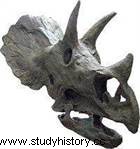 From a scientific point of view the two men agreed on the evolutionary theory, but not on its modalities . Cope was a proponent of neo-Lamarckism (considering that an animal adapts during its lifetime to natural conditions and transmits these transformations to its offspring), while Marsh supported Darwin's ideas (considering that mutations appear randomly and are selected by natural selection). But despite some straining the two friends collaborate on a dig in New Jersey, learning from each other. Cope having discovered a new fossil reptile, he honors his comrade by naming it Colosteus marshii . Grateful, Marsh returns the courtesy with a Mosasaurus copeanus … Everything seems to be going for the best in the best of both worlds between these two men and yet the severe competition will bring out the slightest points of tension between them, cause the rupture and generate a real personal war.
From a scientific point of view the two men agreed on the evolutionary theory, but not on its modalities . Cope was a proponent of neo-Lamarckism (considering that an animal adapts during its lifetime to natural conditions and transmits these transformations to its offspring), while Marsh supported Darwin's ideas (considering that mutations appear randomly and are selected by natural selection). But despite some straining the two friends collaborate on a dig in New Jersey, learning from each other. Cope having discovered a new fossil reptile, he honors his comrade by naming it Colosteus marshii . Grateful, Marsh returns the courtesy with a Mosasaurus copeanus … Everything seems to be going for the best in the best of both worlds between these two men and yet the severe competition will bring out the slightest points of tension between them, cause the rupture and generate a real personal war.
During excavations Marsh, who considers that Cope is not a true professional in Paleontology, does not hesitate to bribe some of his friend's diggers to deliver the fossils found to him. The tension gradually rises between the two protagonists who enter a kind of Cold War, attacking each other through newspapers. Finally the hatchet was definitively unearthed in 1870 when Cope discovered and presented to the general public a marine reptile:the Elasmosaurus . Invited for the occasion, Marsh does not hesitate to humiliate his former friend by publicly pointing out that Cope placed the skull of the Elasmosaurus … At the end of the queue!
The "War of Bones"
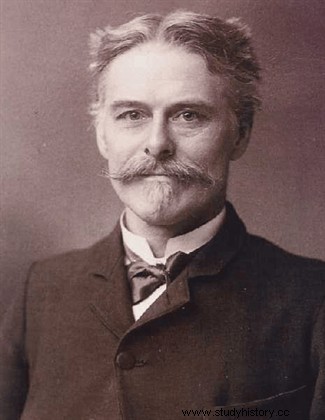 At the same time the scientific community is passionate about the discoveries of the first dinosaurs and museums seek at all costs to acquire new specimens. Glory would go to those who would find a way to excavate the rich fossil deposits of the American West… Sometimes even in the Indian territories… Such expeditions, the hiring of men, supplies, equipment, transport, have a certain cost. To finance Cope benefits from the support of the American Geological Survey. He leaves near Black Buttes in Wyoming where he soon discovers the first horned dinosaur, which he names Agathaumas sylvestris . Luck seems to be smiling on him again, but when he goes to Fort Bridger to pick up the men and the supplies he was waiting for, he finds nothing... A man was behind this strange desertion:Marsh. The latter had succeeded in turning Cope's collaborators over to cut him off from the means to continue his discoveries.
At the same time the scientific community is passionate about the discoveries of the first dinosaurs and museums seek at all costs to acquire new specimens. Glory would go to those who would find a way to excavate the rich fossil deposits of the American West… Sometimes even in the Indian territories… Such expeditions, the hiring of men, supplies, equipment, transport, have a certain cost. To finance Cope benefits from the support of the American Geological Survey. He leaves near Black Buttes in Wyoming where he soon discovers the first horned dinosaur, which he names Agathaumas sylvestris . Luck seems to be smiling on him again, but when he goes to Fort Bridger to pick up the men and the supplies he was waiting for, he finds nothing... A man was behind this strange desertion:Marsh. The latter had succeeded in turning Cope's collaborators over to cut him off from the means to continue his discoveries.
For his part, Marsh continues his own research and always watches Cope's publications with an attentive eye, studies them assiduously and does not miss an opportunity to point out any errors in classification that his colleague may make.
In 1877, near Morisson, two teachers discovered at the same time large deposits of dinosaur fossils. It is even said that a native had made a hut with the bones of a great saurian! The first teacher, Arthur Lakes, hastens to warn Marsh. But the second, Lucas, contacts Cope to tell him of his discoveries. From then on, the two most opposite sizes of Paleontology will converge towards the same point for a fight which already promises to be merciless. Everyone arrives with the same objective:to find as many fossils as possible and describe as many new species as possible.
From the point of view of discoveries Marsh is undoubtedly the luckiest:with blows of dynamite he brings out the ages of dinosaurs such as the Stegosaurus . He names one of his discoveries the Titanosaurus ! But Cope, also on the lookout, hastens to point out that this name is already taken and Marsh must backtrack and find a new name (Atlantosaurus ) :Revenge is a dish best served cold. But on the ground Marsh never stops drawing on his lucky capital, his men who went prospecting even find a gigantic dinosaur cemetery in Wyoming! Marsh is careful to spread the word that he is leaving for Oregon and rushing to Wyoming. 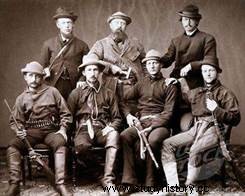 But Cope, who is not fooled, closely follows his sworn enemy and sends some of his men disguised as merchants to spy on the excavations.
But Cope, who is not fooled, closely follows his sworn enemy and sends some of his men disguised as merchants to spy on the excavations.
However, the latter are unmasked and expelled from Como Bluff. Despite storms and an invasion of lizards Marsh and his team continue to discover large Jurassic sauropods such as the Diplodocus and Brontosaurus . For his part Cope is chomping at the bit and out of jealousy does not hesitate to send men to destroy the fossils found by Marsh. One can only deplore such anti-scientific behavior, but Marsh himself did not hesitate to destroy the fossils he could not, or did not want, to remove. All for fear that Cope might collect them and use them.
Somewhat demoralized, some of Cope's men ended up "going over to the enemy" by joining Marsh's excavation site. Marsh will continue his excavations, discovering the Triceratops (which he had first taken for a bison) then continuing his research in Indian territory:in the Dakota. There he enters the lands of the Indian chief Nuage Rouge with whom he obtains an agreement by promising remuneration for any fossil found (in addition to proposing himself as an intermediary of the Indian chief in Washington). But Marsh will have a forked tongue and deceive the Indians by secretly conveying several cartloads of fossils during one of their feasts.
The end of the war, for lack of combatants… Although…
The long duel between the two men would only end with the untimely death of Cope in 1897, at the age of 57. Marsh would join him two years later. Last bravado before dying, Cope requested in his will that his brain be removed and measured. A theory of the time (considered false since) considered that the intelligence of the individual was proportional to the size of his brain. The point, of course, was to entice Marsh to do the same so that science could posthumously confirm the superiority of one over the other...
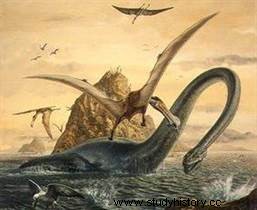 In view of the methods, and even if Marsh wins in points, one can legitimately wonder if there had a winner in this funny war. The only winner, ultimately, is certainly Science. Because despite the destruction caused by this treacherous competition, the two paleontologists unearthed no less than 140 new species of dinosaurs and reptiles from the secondary era! Their descriptions and their cases of fossils were the basis of many works for the generations of paleontologists who succeeded them. Their adventures were the subject of several cinematographic interpretations and the general public fell in love with these extinct creatures, a passion that has not been denied until today!
In view of the methods, and even if Marsh wins in points, one can legitimately wonder if there had a winner in this funny war. The only winner, ultimately, is certainly Science. Because despite the destruction caused by this treacherous competition, the two paleontologists unearthed no less than 140 new species of dinosaurs and reptiles from the secondary era! Their descriptions and their cases of fossils were the basis of many works for the generations of paleontologists who succeeded them. Their adventures were the subject of several cinematographic interpretations and the general public fell in love with these extinct creatures, a passion that has not been denied until today!
Cope's collection is now housed at the New York Museum of Natural History.
Marsh's is still housed in the Peabody Museum of Natural History at Yale University.
Some bone war links
- Schneider François-Pierre, “The “War of Bones” between Marshall and Cope”, in Préhistoire Magazine, N°3, November 2011.
- Cody Kimmel Elizabeth, Dinosaur Bone War:Cope and Marsh's Fossil Feud, Landmark Books.
To discover Paleontology
- Author's paleontological collection
- Eric Buffetaut, Le Loeuf Jean and Le Roux Guy, The Vanished Worlds, Atlas of Continental Drift, Berg International Publisher, 1998.
- Jay Gould Stephen (under the direction of.), The Book of Life, Seuil, 1993.
- Lecointre Guillaume, Critical Guide to Evolution, Belin, 2009.
- Pinna Giovanni, The Fossils, Editions Atlas, 2005.
- Steyer Sebastien, The Earth before the dinosaurs, Belin pour la Science, 2009.
